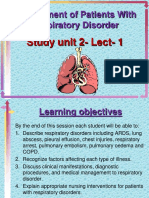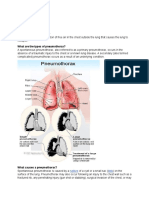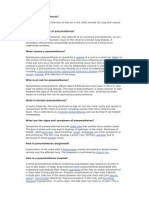Collapsed Lungs
Collapsed Lungs
Uploaded by
Jayson MontemayorCopyright:
Available Formats
Collapsed Lungs
Collapsed Lungs
Uploaded by
Jayson MontemayorOriginal Description:
Copyright
Available Formats
Share this document
Did you find this document useful?
Is this content inappropriate?
Copyright:
Available Formats
Collapsed Lungs
Collapsed Lungs
Uploaded by
Jayson MontemayorCopyright:
Available Formats
Collapsed Lungs (PNEUMOTHORAX)
A collapsed lung occurs when air escapes from the lung. The air then fills the space
outside of the lung, between the lung and chest wall. This buildup of air puts pressure
on the lung, so it cannot expand as much as it normally does when you take a breath.
Signs & Symptoms
1. Typical symptom is a sharp, stabbing pain on one side of the chest, which suddenly
develops.
2.
The pain is usually made worse by breathing in (inspiration).
3.
You may become breathless. As a rule, the larger the pneumothorax, the more
breathless you become.
4.
Tachypnea abnormal rapid breathing
5.
6.
Respiratory distress (considered a universal finding) or respiratory arrest
Bluish color of the skin due to lack of oxygen
Causes
Collapsed lung can be caused by an injury to the lung. Injuries can include a gunshot or
knife wound to the chest, rib fracture, or certain medical procedures.
In some cases, a collapsed lung is caused by air blisters (blebs) that break open,
sending air into the space around the lung. This can result from air pressure changes
such as when scuba diving or traveling to a high altitude.
In some cases, a collapsed lung occurs without any cause. This is called a spontaneous
collapsed lung.
Diagnostics Examinations
1. Lungs Auscultation
Asymmetric lung expansion: Mediastinal and tracheal shift to contralateral side
(large tension pneumothorax)
Distant or absent breath sounds: Unilaterally decreased/absent lung sounds
common, but decreased air entry may be absent even in advanced state of
pneumothorax
Decreased Tactile Fremitus- is a vibration transmitted through the body.[1] In
common medical usage, it usually refers to assessment of the lungs by either the
vibration intensity felt on the chest wall (tactile fremitus) and/or heard by a
stethoscope on the chest wall with certain spoken words (vocal fremitus),
although there are several other types.
Adventitious lung sounds: Ipsilateral crackles, wheezes
2. Cardiovascular findings may include the following:
Tachycardia: faster than 135 beats/min
Pulsus paradoxus- is an abnormally large decrease in systolic blood pressure and
pulse wave amplitude during inspiration.
Hypotension: Inconsistently present finding; although typically considered a key sign of
tension pneumothorax, hypotension can be delayed until its appearance immediately
precedes cardiovascular collapse
Jugular venous distention: Generally seen in tension pneumothorax; may be absent if
hypotension is severe.
3. Chest Radiography
4. Chest computed tomography scanning: Most reliable imaging study for diagnosis of
pneumothorax but not recommended for routine use in pneumothorax
5. Arterial blood gas (ABG)
Management
The range of medical therapeutic options for pneumothorax includes the following:
Watchful waiting, with or without supplemental oxygen
Simple aspiration
Chest tube
Surgery
If the patient has had repeated episodes of pneumothorax or if the lung remains
unexpanded after 5 days with a chest tube in place, operative therapy such as the
following may be necessary:
Thoracoscopy: Video-assisted thoracoscopic surgery (VATS)
Electrocautery: Pleurodesis or sclerotherapy
Laser treatment
Resection of blebs or pleura
Open thoracotomy
Pharmacotherapy
The following medications may be used to aid in the management of patients with
pneumothorax:
Local anesthetics (eg, lidocaine hydrochloride)
Opioid anesthetics (eg, fentanyl citrate, morphine)
Benzodiazepines (eg, midazolam, lorazepam)
Antibiotics (eg, doxycycline, cefazolin)
You might also like
- Medicine in Brief: Name the Disease in Haiku, Tanka and ArtFrom EverandMedicine in Brief: Name the Disease in Haiku, Tanka and ArtRating: 5 out of 5 stars5/5 (1)
- PneumothoraxDocument14 pagesPneumothoraxRoberth Belmonte RiveraNo ratings yet
- Dyspnea Is An Uncomfortable Abnormal Awareness of Breathing. A Number of DifferentDocument4 pagesDyspnea Is An Uncomfortable Abnormal Awareness of Breathing. A Number of DifferentSita SifanaNo ratings yet
- Wa0039.Document20 pagesWa0039.shadesofcuddaloreNo ratings yet
- Respiratory System Assessment: Other SystemsDocument4 pagesRespiratory System Assessment: Other SystemsChetan Kumar100% (1)
- Case Study For PneumothoraxDocument4 pagesCase Study For PneumothoraxGabbii CincoNo ratings yet
- PneumologyDocument117 pagesPneumologymavaddati.saraNo ratings yet
- Pneumothorax: Risk Factors For A PneumothoraxDocument12 pagesPneumothorax: Risk Factors For A Pneumothoraxyangi dokaNo ratings yet
- Breath Sounds: ConsiderationsDocument10 pagesBreath Sounds: ConsiderationsKarl RobleNo ratings yet
- Chest PainDocument94 pagesChest PainZubair SoomroNo ratings yet
- DyspneaDocument7 pagesDyspneaTara WandhitaNo ratings yet
- Respiratory System History Taking: Dr. Aiman Al ShareiDocument20 pagesRespiratory System History Taking: Dr. Aiman Al ShareiQusai IbraheemNo ratings yet
- Chest Trauma: DR - Amr BastawaisiDocument10 pagesChest Trauma: DR - Amr BastawaisiBara FakhryNo ratings yet
- My Cardiac and Chest SymptomsDocument58 pagesMy Cardiac and Chest SymptomsDhamirah SakinahNo ratings yet
- Study Unit 11 - Resp Disorder ReviewdDocument63 pagesStudy Unit 11 - Resp Disorder Reviewdسليمان العطويNo ratings yet
- What Is A Pneumothorax?Document7 pagesWhat Is A Pneumothorax?llyrycNo ratings yet
- Chest Trauma Tuelo& MathopaDocument51 pagesChest Trauma Tuelo& MathopaTuelo 02No ratings yet
- Group 7airway Emergencies WordDocument7 pagesGroup 7airway Emergencies WordDukuzumuremyi FabriceNo ratings yet
- Lec1 of Symptomatology of Chest DiseasesDocument26 pagesLec1 of Symptomatology of Chest Diseasesmenna hanyNo ratings yet
- AtelectasisDocument3 pagesAtelectasisMicah MagallanoNo ratings yet
- Chest InjuriesDocument8 pagesChest InjuriesNavjot BrarNo ratings yet
- Get Homework/Assignment DoneDocument9 pagesGet Homework/Assignment DoneHomework PingNo ratings yet
- Assessment of Patients With Repiratory ProblemsDocument33 pagesAssessment of Patients With Repiratory Problemshunter zoneNo ratings yet
- Vishtasb DiagnosticDocument24 pagesVishtasb DiagnosticVishtasb KhaliliNo ratings yet
- Pneumothorax and Pneumomediastinum: Dr. Emad EfatDocument89 pagesPneumothorax and Pneumomediastinum: Dr. Emad Efatinterna MANADONo ratings yet
- Thoracic Pathology: Dr. Fatima Ejaz PT Ms Neuro Physical TherapyDocument24 pagesThoracic Pathology: Dr. Fatima Ejaz PT Ms Neuro Physical Therapykim suhoNo ratings yet
- Pneumonia IsDocument17 pagesPneumonia IsRadman Dormendo ItelluNo ratings yet
- Tension MedscapeDocument24 pagesTension MedscapeHandayaniNo ratings yet
- Merged 37Document21 pagesMerged 37abdulkreemsalem4No ratings yet
- PneumothoraxDocument6 pagesPneumothoraxNader Smadi100% (1)
- The Thorax and Lungs - BATESDocument4 pagesThe Thorax and Lungs - BATESsitalcoolk100% (2)
- Cardiopulmonary Symptoms: Chapter OutlineDocument24 pagesCardiopulmonary Symptoms: Chapter OutlinedinakarcNo ratings yet
- Cardio AssessmentDocument118 pagesCardio AssessmentNashrina NashrinaNo ratings yet
- Session 9 - 10 Respiratory System - FullDocument106 pagesSession 9 - 10 Respiratory System - FullNirmeen SalamehNo ratings yet
- Complications and Prognosis PhenomotoraxDocument7 pagesComplications and Prognosis PhenomotoraxSifa Nafizhah Azahra JemsiiNo ratings yet
- 2 5215416471575865318Document5 pages2 5215416471575865318b5mkn9h6pkNo ratings yet
- Performing Respiratory System ExaminationDocument30 pagesPerforming Respiratory System Examinationpatriciacharles096No ratings yet
- PneumothoraxDocument7 pagesPneumothoraxjutah2013No ratings yet
- What Is A PneumothoraxDocument2 pagesWhat Is A PneumothoraxpawnayNo ratings yet
- PneumothoraxDocument3 pagesPneumothoraxYara YousefNo ratings yet
- Pneumothorax 1Document4 pagesPneumothorax 1Monika AyuningrumNo ratings yet
- Abnormal Lung SoundDocument5 pagesAbnormal Lung Soundabdelrahman.younis20No ratings yet
- Chest TraumaDocument9 pagesChest Traumaapi-3838240100% (7)
- Medterm July 20Document11 pagesMedterm July 20sandra seguienteNo ratings yet
- OxygenaionDocument20 pagesOxygenaionShreyashi sahaNo ratings yet
- Clinical ManifestationsDocument37 pagesClinical Manifestationsمدونة الأحترافNo ratings yet
- PBL Respi 1 Week 1Document6 pagesPBL Respi 1 Week 1FrinkaWijayaNo ratings yet
- 5) AssessmentDocument35 pages5) Assessmentbikedet268No ratings yet
- Pneumothorax (Collapsed Lung) : What Is A Pneumothorax?Document17 pagesPneumothorax (Collapsed Lung) : What Is A Pneumothorax?Hazel EstayanNo ratings yet
- Pleural Diseases WordDocument7 pagesPleural Diseases WordAbid RasheedNo ratings yet
- Chest Injuries: On The Basis of Mechanism of Injury On The Basis of Anatomical Part InvolvementDocument8 pagesChest Injuries: On The Basis of Mechanism of Injury On The Basis of Anatomical Part InvolvementmalathiNo ratings yet
- AtelectasisDocument30 pagesAtelectasisashoaib0313No ratings yet
- EmphysemaDocument3 pagesEmphysemaKhalid Mahmud ArifinNo ratings yet
- Thoracic Trauma - BS Lý HuyDocument13 pagesThoracic Trauma - BS Lý Huyminhkhanh30081999No ratings yet
- Respiratory System-Review PathoDocument100 pagesRespiratory System-Review PathoSadiePartington-Riopelle100% (1)
- Dyspnea: CausesDocument7 pagesDyspnea: CausesGetom NgukirNo ratings yet
- Chest and Abdominal Injuries: Forensic Medicine by Yazan AbueidehDocument54 pagesChest and Abdominal Injuries: Forensic Medicine by Yazan AbueidehRayyan Alali100% (1)
- Trauma Thorax: Fandi Dwi CahyandiDocument50 pagesTrauma Thorax: Fandi Dwi CahyandiYanuar Yudha SudrajatNo ratings yet
- Pleurisy, A Simple Guide To The Condition, Treatment And Related ConditionsFrom EverandPleurisy, A Simple Guide To The Condition, Treatment And Related ConditionsNo ratings yet
- A Simple Guide to Pneumothorax (Collapsed Lungs), Diagnosis, Treatment and Related ConditionsFrom EverandA Simple Guide to Pneumothorax (Collapsed Lungs), Diagnosis, Treatment and Related ConditionsNo ratings yet
- Acute and Chronic Low Low Back PainDocument13 pagesAcute and Chronic Low Low Back PainMilner GranadosNo ratings yet
- Speech PhysiologyDocument42 pagesSpeech PhysiologyAttiqaQureshiNo ratings yet
- Specialty Pharmacy: Jennifer Johnson, Pharmd Lizzie Riley-Jensen, PharmdDocument13 pagesSpecialty Pharmacy: Jennifer Johnson, Pharmd Lizzie Riley-Jensen, Pharmdapi-748317258No ratings yet
- Surgery ( Rdit Medicine and Pathology: 12 Number 5 May. 1959Document15 pagesSurgery ( Rdit Medicine and Pathology: 12 Number 5 May. 1959Srishti SyalNo ratings yet
- The Perfect Guide To Understanding Diabetes: Monica Danforth BSC 1008 24 July 2011 Professor RiveroDocument17 pagesThe Perfect Guide To Understanding Diabetes: Monica Danforth BSC 1008 24 July 2011 Professor RiveroDan ZkyNo ratings yet
- DHA Health Facility Guidelines 2019: Part B - Health Facility Briefing & Design 20 - Admissions Unit & DischargeDocument30 pagesDHA Health Facility Guidelines 2019: Part B - Health Facility Briefing & Design 20 - Admissions Unit & Dischargechandan guptaNo ratings yet
- Anesthesiology SamplexDocument17 pagesAnesthesiology SamplexAudrey CobankiatNo ratings yet
- Clinical Elective GuideDocument40 pagesClinical Elective Guidekabal321No ratings yet
- Failures of Root Canal TreatmentDocument77 pagesFailures of Root Canal Treatmenthardeep kaurNo ratings yet
- Prosthodontic ManualDocument129 pagesProsthodontic ManualAhmed Elbieh100% (1)
- Emergency Concierge Position DescriptionDocument4 pagesEmergency Concierge Position Descriptionm2mv7ndg4bNo ratings yet
- Primulae RadixDocument6 pagesPrimulae RadixNijole SavickieneNo ratings yet
- Norton Healthcare News: January 2008Document12 pagesNorton Healthcare News: January 2008Norton HealthcareNo ratings yet
- Vanderbilt Rating Scale Scoring InstructionsDocument2 pagesVanderbilt Rating Scale Scoring InstructionsYeon Ae Narita100% (3)
- Professional ReferenceDocument2 pagesProfessional ReferenceFrancis Contaoi100% (1)
- Acute Respiratory Failure For StudentDocument41 pagesAcute Respiratory Failure For Studentapi-379952350% (4)
- Satera Gause Annotated BibDocument3 pagesSatera Gause Annotated Bibapi-264107234No ratings yet
- Log Book Vascular Surgery - UpdatedDocument20 pagesLog Book Vascular Surgery - UpdatedDiaa El-DinNo ratings yet
- Assignment 1 DB F22Document2 pagesAssignment 1 DB F22Saad MehmoodNo ratings yet
- Neuromyelitis Optica: Mark J. Morrow, MD, Dean Wingerchuk, MD, MSC, FRCP (C)Document13 pagesNeuromyelitis Optica: Mark J. Morrow, MD, Dean Wingerchuk, MD, MSC, FRCP (C)sidogra100% (1)
- Case PresentationDocument10 pagesCase PresentationWina Hanriyani0% (1)
- Acute Stress Disorder in PhysicalDocument14 pagesAcute Stress Disorder in PhysicalKusnanto Penasehat Kpb RyusakiNo ratings yet
- Directory: A Directory of Local Health & Wellness ProfessionalsDocument20 pagesDirectory: A Directory of Local Health & Wellness ProfessionalsEastAuroraAdvertiserNo ratings yet
- EBNDocument18 pagesEBNRais HasanNo ratings yet
- Bill of The Magna Carta of PatientDocument13 pagesBill of The Magna Carta of PatientjuhlynNo ratings yet
- Idiopathic Postural HvpotensionDocument5 pagesIdiopathic Postural HvpotensionGonzalo ReitmannNo ratings yet
- Bed Side Teaching: Siska Sarwana 712015035 Dr. Rizal Daulay, SP - OT, MARSDocument20 pagesBed Side Teaching: Siska Sarwana 712015035 Dr. Rizal Daulay, SP - OT, MARSAde ZulfiahNo ratings yet
- Open EMRDocument38 pagesOpen EMRSuhail BhatiaNo ratings yet
- ADC Suggested Books PDFDocument22 pagesADC Suggested Books PDFFaisal ShahabNo ratings yet
- B-Univ QuesDocument33 pagesB-Univ QuesParamesh NdcNo ratings yet

























































































